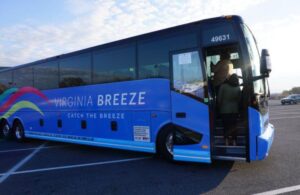The Virginia Department of Rail and Public Transportation (DRPT) subsidizes three bus routes connecting communities in Southside and Southwest Virginia to population centers to the north. One of those, the Valley Flyer, links Blacksburg and Virginia Tech, ferrying college students to Northern Virginia and back. It carried more than 2,800 passengers in the 1st quarter of 2021. The farebox recovery was 45%, and the average cost per passengers was a modest $45.33, according to DRPT’s Virginia Breeze Bus Lines 1st Quarter 2021 report. Not bad as far as public transportation goes.
A second line, the Capital Connector, connects Martinsville with Richmond and Northern Virginia. It carried 820 passengers in the 1st quarter, for a 10% farebox recovery and an average cost per passenger of $231.60. Not so good.
Then there is the Piedmont Express, commencing in Danville and running through Altavista, Lynchburg, Amherst, Charlottesville, Culpeper, Warrenton, Gainesville and Dulles airport before terminating in Washington. The 1st quarter passenger count was 269, the farebox recovery 5%, and the average cost per passenger $729.63.
Zero passengers stopped in Amherst, Altavista and Warrenton that quarter. Only one stopped in Lynchburg and one in Gainesville.
For purposes of comparison you can rent a Lexus in the Washington metropolitan area for around $60 per day, and drive it up to 600 miles. The distance between Washington, D.C., and Martinsville is 300 miles. The Lexus gets 22 miles per gallon, which implies a consumption of 15 gallons. At $3 per gallon, that’s $45 for gasoline.
Here’s a suggestion for DRPT: Lease a fleet of Lexus automobiles and let would-be bus passengers drive them to Northern Virginia for free. It’ll save a whole lot of money, and I’ll bet the passengers will enjoy the trip a lot more.
This is insanity. It’s not as if there isn’t vigorous private-sector competition vying for the meager traffic between small towns — like Greyhound, Trailways and Megabus. If there is money to be made, those companies will sniff it out. If there is insufficient demand to support a private route, what justification is there for DRPT to squander taxpayer dollars?


Leave a Reply
You must be logged in to post a comment.